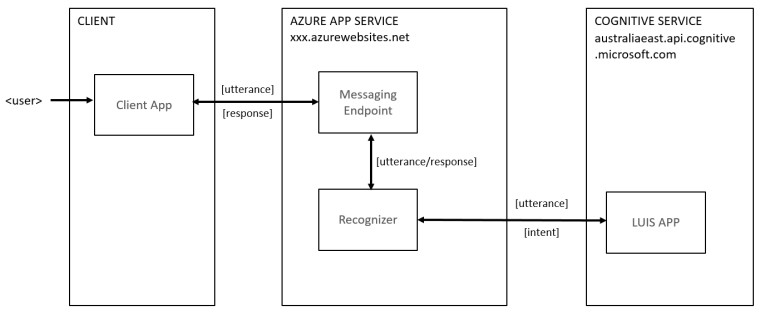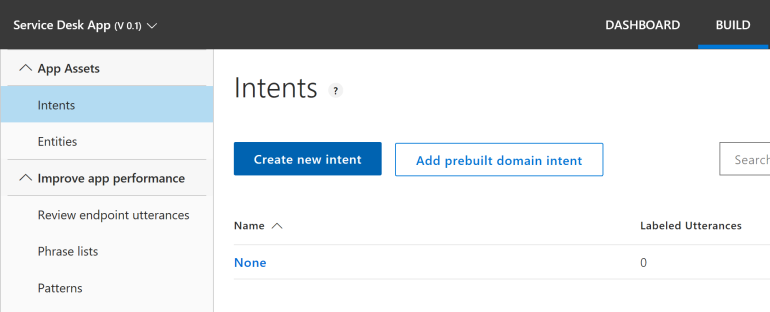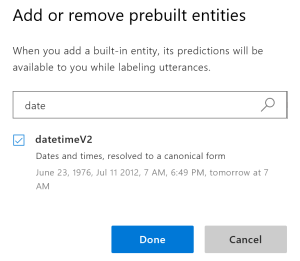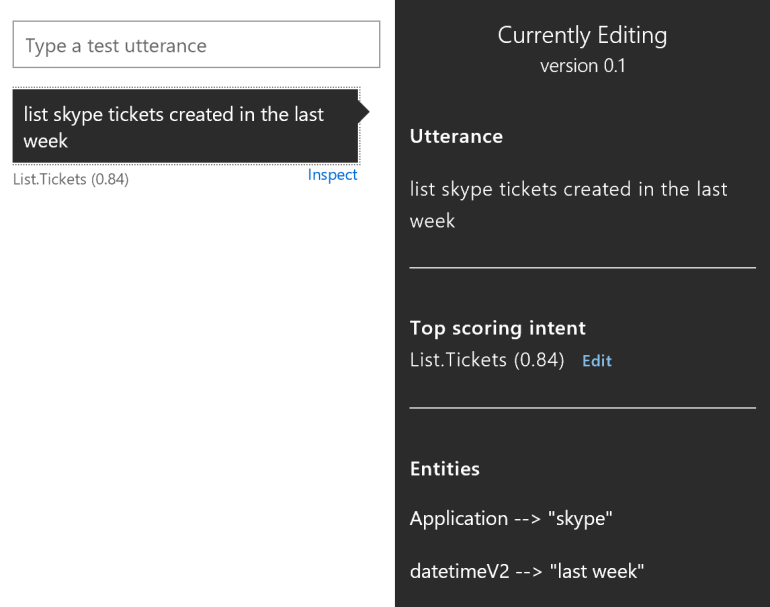
Some modern applications must understand time, because the messages they receive contain time sensitive information. Consider a modern Service Desk solution, that may have to retrieve tickets based on a date range (the span between dates) or a duration of time.
In this blog post, I’ll explain how bots can interpret date ranges and durations, so they can respond to natural language queries provided by users, either via keyboard or microphone.
First, let’s consider the building blocks of a bot, as depicted in the following view:

The client runs an application that sends messages to a messaging endpoint in the cloud. The connection between the client and the endpoint is called a channel. The message is basically something typed or spoken by the user.
Now, the bot must handle the message and provide a response. The challenge here is interpreting what the user said or typed. This is where cognitive services come in.
A cognitive service is trained to take an message from the user and resolve it into an intent (a function the bot can then execute). The intent determines which function the bot will execute, and the resulting response to the user.
To build time/date intelligence into a bot, the cognitive service must be configured to recognise date/time sensitive information in messages, and the bot itself must be able to convert this information into data it can use to query data sources.
Step 1: The Cognitive Service
In this example, I’ll be using the LIUS cognitive service. Because my bot resides in an Australia based Azure tenant, I’ll be using the https://au.luis.ai endpoint. I’ve created an app called Service Desk App.

Next, I need to build some Intents and Entities and train LUIS.
- An Entity is an thing or phrase (or set of things or phrases) that may occur in in an utterance. I want LUIS (and subsequently the bot) to identify such entities in message provided to it.
The good news is that LUIS has a prebuilt entity called datetimeV2 so let’s add that to our Service Desk App. You may also want to add additional entities, for example: a list of applications managed by your service desk (and their synonyms), or perhaps resolver groups.

Next, we’ll need an Intent so that LUIS can have the bot execute the correct function (i.e. provide a response appropriate to the message). Let’s create an Intent called List.Tickets.
- An Intent, or intention represents something the user wants to do (in this case, retrieve tickets from the service desk). A bot may be designed to handle more than one Intent. Each Intent is mapped to a function/method the bot executes.
I’ll need to provide some example utterances that LUIS can associate with the List.Tickets intent. These utterances must contain key words or phrases that LUIS can recognise as entities. I’ll use two examples:
- “Show me tickets lodged for Skype in the last 10 weeks”
- “List tickets raised for SharePoint after July this year”
Now, assuming I’ve created an list based entity called Application (so LUIS knows that Skype and SharePoint are Applications), LUIS will recognise these terms as entities in the utterances I’ve provided:

Now I can train LUIS and test some additional utterances. As a general rule, the more utterances you provide, the smarter LUIS gets when resolving a message provided by a user to an intent. Here’s an example:

Here, I’ve provided a message that is a variation of utterances provided to LUIS, but it is enough for LUIS to resolve it to the List.Tickets intent. 0.84 is a measure of certainty – not a percentage, and it’s weighted against all other intents. You can see from the example that LUIS has correctly identified the Application (“skype”), and the measure of time (“last week”).
Finally, I publish the Service Desk App. It’s now ready to receive messages relayed from the bot.
Step 2: The Bot
Now, it’s possible to create a bot from the Azure Portal, which will automate many of the steps for you. During this process, you can use the Language Understanding template to create a bot with a built in LUISRecognizer, so the code will be generated for you.
- A Recognizer is a component (class) of the bot that is responsible determining intent. The LUISRecognizer does this by relaying the message to the LUIS cognitive service.
Let’s take a look at the bot’s handler for the List.Tickets intent. I’m using Node.js here.
The function that handles the List.Tickets intent uses the EntityRecognizer class and findEntity method to extract entities identified by LUIS and returned in the payload (results).
It passes these values to a function called getData . In this example, I’m going to have my bot call a (fictional) remote service at http://xxxxx.azurewebsites.net/Tickets. This service will support the Open Data (OData) Protocol, allowing me to query data using the query string. Here’s the code:
(note I am using the sync-request package to call the REST service synchronously).
Step 3: Chrono
So let’s assume we’ve sent the following message to the bot:
- “List tickets raised for SharePoint after July this year”
It’s possible to query an OData data source for date based information using syntax as follows:
- $filter=CreatedDate gt datetime’2018-03-08T12:00:00′ and CreatedDate lt datetime’2018-07-08T12:00:00′
So we need to be able to convert ‘after July this year’ to something we can use in an OData query string.
Enter chrono-node and dateformat – neat packages that can extract date information from natural language statements and convert the resulting date into ISO UTC format respectively. Let’s put them both to use in this example:
It’s important to note that chrono-node will ignore some information provided by LUIS (in this case the word ‘after’, but also ‘last’ and ‘before’), so we need a function to process additional information to create the appropriate filter for the OData query:
Handling time sensitive information is a crucial when building modern applications designed to handle natural language queries. After all, wouldn’t it be great to ask for information using your voice, Cortana, and your mobile device when on the move! For now, these modern apps will be dependent on data in older systems with APIs that require dates or date ranges in a particular format.
The beauty of languages like Node.js and the npm package manager is that building these applications becomes an exercise in assembling building blocks as opposed to writing functionality from scratch.
